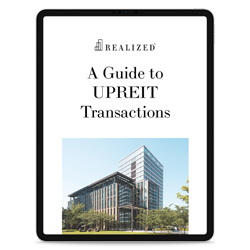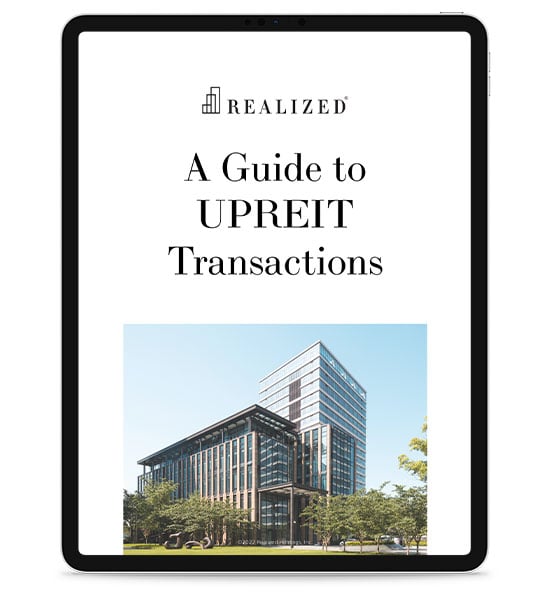
Participating in an umbrella partnership real estate investment trust (UPREIT) can offer certain advantages, such as tax deferral and diversification. As you contribute your real estate assets in exchange for operating partnership (OP) units, you often benefit from reduced management responsibilities and regular income distributions. However, some investors may want to return to direct property ownership for a variety of reasons.
The question is, can you revert an UPREIT structure back to direct property ownership? Yes, this is theoretically possible, but it’s not easy and may not result in the reality you’re hoping for.
Unwinding the UPREIT arrangement can be complex, and many investors and advisors find this process impractical. Below, Realized 1031 has shared an article exploring these challenges and why entering an UPREIT is usually a one-way street.
Why You May Consider UPREIT to Direct Property Conversions
There are various reasons why an investor may want to return to direct ownership after entering an UPREIT.
- Regain Control: Rules outlined by Section 721 typically require giving up direct control over property management decisions. Investors who still want to maintain full control of their assets may find this arrangement limiting.
- Estate Planning: Some estate strategies may prefer direct property for stepped-up basis planning or for other tax-related considerations..
- Tax Positioning: There are cases when investors want to return to direct ownership to reset or simplify their tax situation, especially regarding capital gains or depreciation recapture.
- Market Preference: Based on trends or forecasted economic conditions, some may determine that direct property ownership better aligns with their preferences compared to holding interests through a publicly traded REIT.
Reverting a 721 to Direct Property Ownership Is Complicated
The structure of a UPREIT itself makes the conversion complex, if possible at all. When you contribute your property, it’s converted into OP units, which are the economic equivalent of REIT shares. The REIT becomes the new owner of your contributed assets, so they’re no longer under your direct control. Such an arrangement creates the following challenges.
Complicated Legal Structure
As your assets become a part of the REIT’s pool of real estate properties, you lose direct ownership. If you want to revert, separating these properties from the portfolio is not straightforward, and the REIT may not even allow it unless you have a strong justification.
Tax Triggers
Attempting to take back your contributed property would likely trigger a taxable event. Specifically, the capital gains tax deferred under Section 721 would generally become due at the time of reversion, depending on the transaction structure and investor’s tax profile.
Lack of Precedent
Given how UPREIT investments are designed to be long-term, there are no processes or provisions that outline how to revert OP units back to direct ownership. Of course, laws can change, but there is currently no compelling public policy or economic reason that would typically motivate the IRS or other governing bodies to create such new rules.
Due to these challenges, the only direct option you have is to work with the REIT for a way to reverse your units. However, realistically speaking, this step is a long shot.
Possible Workarounds and Alternatives
While a full reversion is rare and difficult, there are alternative approaches that may achieve similar outcomes, depending on the investor’s goals and circumstances.
- Convert OP Units and Sell the Shares: Through this step, you gain funds to purchase a new property directly. Be aware, though, that conversion is generally a taxable event and may trigger capital gains taxes.
- Negotiate a Property Spin-Off: In rare cases, an investor with significant influence or a major stake in a REIT may negotiate for the REIT to “spin off” or sell a particular property back to them. However, this must be done at fair market value and could still trigger tax liabilities.
- Choosing a 1031 Exchange: While a 721 to 1013 exchange is also not directly allowed, you can choose the latter as the tax-deferral strategy instead of contributing assets to an UPREIT. A 1031 exchange allows for tax deferral while maintaining direct ownership of the replacement property, subject to IRS requirements and timing rules.
Wrapping Up: Is It Possible to Convert UPREIT Shares to Direct Property Ownership?
While it’s theoretically possible to revert UPREIT OP units to direct property ownership, it’s a complex and rare event that doesn’t have any outlined process. Investors considering UPREIT participation may wish to engage in proactive planning to ensure the structure aligns with their long-term ownership preferences and tax strategies.
The tax and estate planning information offered by the advisor is general in nature. It is provided for informational purposes only and should not be construed as legal or tax advice. Always consult an attorney or tax professional regarding your specific legal or tax situation.
Article written by: Story Amplify. Story Amplify is a marketing agency that offers services such as copywriting across industries, including financial services, real estate investment services, and miscellaneous small businesses.
Sources:
https://www.investopedia.com/financial-edge/0110/10-things-to-know-about-1031-exchanges.aspx



